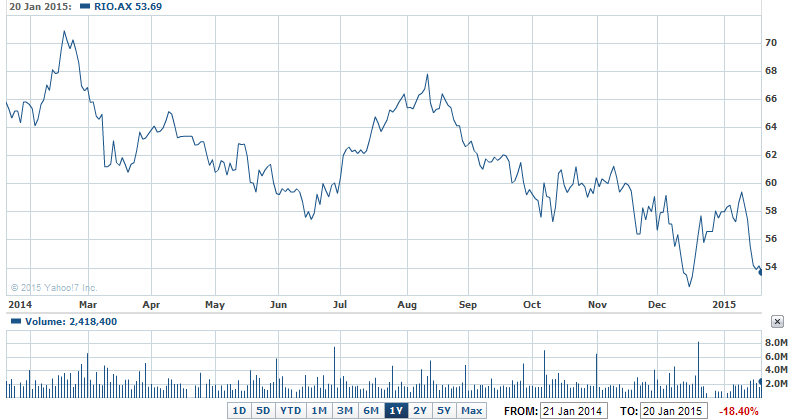Now for the cash and other rewards for Rio Tinto’s (RIO) shareholders to make sure the would-be boarder, Glencore, remains at arms length.
The mining giant, the world’s biggest iron ore exporter, once again produced and sold more iron ore than it promised in 2014.
And Rio is promising more of the same this year – despite the slide in world prices – prices are around $US68 a tonne, down from the $US84.30 average price received in 2014.
Now for the annual profit announcement on February 12.
Rio’s 2015 profit will be of interest, but the real focus will be on the expected lift in the final dividend and plans for a reported $US5 billion or more in capital management initiatives over the next few years (a buyback?).
The company has already promised to reveal “materially increased” returns to shareholders at the annual results announcement.
That was before the steep slide in oil prices (a big positive for Rio) and the sharp recent fall in copper prices, a negative for the company, especially with its own copper production performance this year expected to be weak.
RIO 1Y – Rio set to lift shareholder returns?

In its 4th quarter and full year production and sales report released yesterday, Rio revealed that its flagship iron ore division had narrowly beaten its target of 295 million tonnes, by exporting 295.4 million tonnes of ore in the year from Australia. That was up 11%, while Rio’s share was up 12%.
But Rio drew down stocks and sold 7.2 million tonnes more than it produced in 2014, to boost total sales to 302.6 million tonnes from its Australian and Canadian mines, up 17% from 2013.
Rio’s share 239.9 million tonnes was also up 17% on 2013 – but that won’t go anywhere near offsetting the 50% plus slide in world iron ore prices last year.
Mined copper production for the year was up 4% and thanks to the build up of production at the Oyu Tolgoi mine in Mongolia.
This increase, along with higher grades at both Oyu Tolgoi and Kennecott in the US, boosted gold output 6% in 2014, over 2013 to 603,100 tonnes.
Global bauxite production was cut by 3% last year as the Gove operation in Australia is restructured to just bauxite exports only after the alumina refinery was shut in May last year.
Aluminium production in 2014 was broadly in line with 2013, despite the closure of of one smelter in November 2013 and the partial shutdown at another in Canada.
Excluding production from the Clermont mine in Queensland which was sold during the year, thermal coal production increased by 15% or (2.5 million tonnes) last year compared to 2013.
That was due to extensive restructuring, especially at the Hunter Valley mines in NSW. Sales of thermal type coal were 25.1 million tonnes in the year, about a million more than its target.
Looking to this year, Rio now expects to dig 330 million tonnes of iron ore from the Australian operations it controls in 2015. And it aims a further increase in production of iron-ore in the Pilbara to at least 350 million tonnes by 2017.
The company is not worried by the prospect of slower growth in China – forecast yesterday by the IMF which chopped its 2015 estimate to 6.8% from the 24 year low of 74% last year. Rio, BHP Billiton, Fortescue and Vale of Brazil seem to be determined to continue pushing as much iron ore as possible onto world markets to prevent competitors gaining valuable sales and market share in the Chinese market.
Glencore doesn’t like that (it doesn’t understand the thinking), but it is under pressure itself from still falling coal prices and the slide in copper, lead and zinc prices.
And in a tough year for the copper business (with its Kennecott operations in the US and the Escondida mine in Chile facing lower mining grades) the Oyu Tolgoi mine should do better in 2015 than 2014.
Turquoise Hill Resources (51% owned by Rio) reported yesterday that it would produce between 170,000 to 195,000 tonnes of copper and between 600,000 and 700,000 ounces of gold in 2015.
Both results will be up on 2014 production levels, which was 148,400 tonnes of copper and 589,000 ounces of gold in concentrates.
In a statement with the report, Rio Tinto chief executive Sam Walsh said, “We have had a successful year of production, capped off with a robust fourth quarter. Output is in line with our targets across all of our major products. In a challenging market Rio Tinto remains focused on operating and commercial excellence to leverage our low-cost position and maximise value for shareholders.”
Rio shares were down 0.3% to $53.98.
Judgement is being withheld until the profit announcement in three weeks. And Glencore is due to release its latest results on the same day as Rio.













